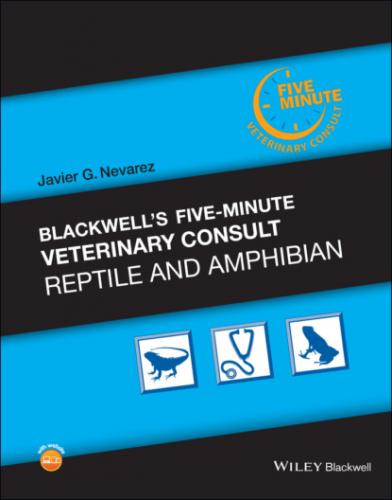As the body begins to break down adipose tissue stores and muscle, bony prominences become more obvious as body condition decreases.
SIGNALMENT/HISTORY
Anorexia has no age or sex predilection.
It is important to differentiate physiologic/behavioral anorexia from that caused by an underlying pathology or disease process.
CLINICAL PRESENTATION
An isolated incident or occasional episodes of anorexia in otherwise healthy animals may be inconsequential, especially in animals presenting in good body condition.
Decreased food intake over an extended period.
Clients may report repeated attempts at feeding.
Clinical signs of chronic anorexia include a decreased body condition score with prominent bony protuberances, dehydration, and muscle wasting.
RISK FACTORS
Any disease process could result in anorexia.
Different types of stress may also result in decreased food intake.
Husbandry
Adjusting to captivity—often seen in newly acquired animals. A period of time for acclimation may be necessary before an animal feels secure enough to start eating on its own.
Improper husbandry—inappropriate environmental temperature or humidity, inappropriate food items (type and/or size), malnutrition, inadequate exposure to UVB lighting, poor water quality, overcrowding, rapid change of diet, lack of provision of hiding areas.
Stress—social or environmental.
Others
Physiologic
Cardiovascular disease: cardiomyopathy, congestive heart failure
Reproductive activity: gravid females, breeding males
Reproductive disease: pre‐ or postovulatory dystocia
Respiratory infections: upper and lower respiratory tract infections; mycoplasmosis
Viral infections: herpesviral infections in Testudo spp; ranaviral infections; iridoviral infections
Fungal infections: fungal pneumonia
Systemic illness: septicemia
GI disease: stomatitis, foreign bodies, neoplasia, intussusception, gastroenteritis, constipation, prolapses
Parasitic disease: ectoparasites and endoparasites
Neurologic disease
Toxic diseases
Urogenital: cystoliths; prolapsed phallus; renal disease
Metabolic: nutritional secondary hyperparathyroidism; hypovitaminosis A
Any potentially painful condition: ophthalmic disease, orthopedic conditions (including shell fractures), cellulitis, trauma
DIFFERENTIAL DIAGNOSIS
Conditions that result in failed food prehension (disorders of the tongue or oral cavity) or processing may result in animals that attempt to eat (have an appetite) but are unable to do so successfully.
Hypophagia may be mistaken for anorexia in certain circumstances.
DIAGNOSTICS
Diagnostic procedures should be tailored towards identifying the underlying cause of the anorexia and identifying potential negative sequelae (e.g., hepatic lipidosis).
Baseline Blood Work
CBC, PCV, TS, biochemistry
Findings on complete blood count and biochemistry panels are usually non‐specific but may be suggestive of an underlying disease process(es) resulting in the observed anorexia.
Bile acids and liver leakage enzymes (AST) may be increased if hepatic lipidosis is present secondary to prolonged anorexia.
Imaging
Radiography can help identify abnormalities of the GI tract such as foreign bodies and masses. Ultrasound and CT can provide more detailed information about possible hepatic lipidosis, ileus, and coelomic masses.
Other Tests
Additional diagnostics, including infectious or parasitic disease testing, may be warranted based on patient history and physical examination findings.
The presumed underlying causes should be thoroughly investigated.
PATHOLOGICAL FINDINGS
Findings depend on underlying cause of the anorexia.
Hepatic lipidosis may be suspected based on the findings of advanced imaging or biochemistry evaluation.
APPROPRIATE HEALTH CARE
N/A
NUTRITIONAL SUPPORT
Nutritional support should be started in anorectic animals that have lost 10% of their body weight acutely (7 days or less) or 20% chronically (longer than 7 days).
This weight loss must also be monitored together with an assessment of body condition (BCS).
Anorectic animals with a BCS of 2/5 or lower may be immediate candidates for nutritional support.
Animals should be housed in appropriate environments and maintained at their preferred optimum temperature zones, to facilitate proper utilization of the provided nourishment.
Liquid diets may be provided via gavage in smaller animals.
Placement of an esophagostomy tube should be considered for long‐term support and to minimize stress of force feeding.
Although poorly understood in veterinary medicine, the potential exists for refeeding syndrome in chronically anorectic patients, necessitating careful planning of nutritional support in these animals.
Recommendations include feeding chronically anorectic animals half their calculated energy requirements initially, then slowly increasing up to the full energy requirement over 7–10 days.
CLIENT EDUCATION/HUSBANDRY RECOMMENDATIONS
The clinician should perform a thorough review of the patient’s current husbandry, including feeding.
It is important to ensure that a proper diet of an appropriate size is being offered.
The
